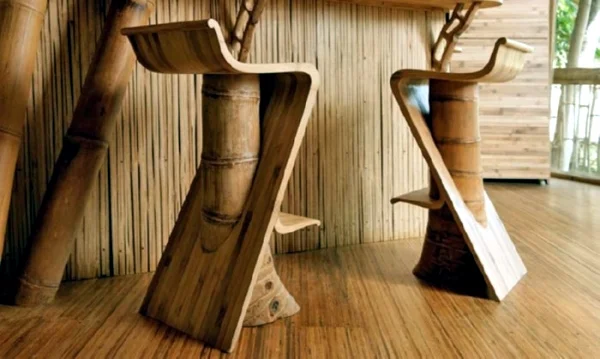Bamboo and Bamboo Furniture: Wood is an excellent selection in terms of outdoor furniture elements, but unluckily for some people, it does not come as cost-efficient. A sole chair ranges from 150-200 dollars, and a full set is an easy grand. But if you are only after the feel and look of a wood, there are other cheap options, just like the bamboo. Further, if you don’t consider furniture as a huge investment of money, bamboo is the most practical option. Read out to know more about bamboo:
Sun rise on a bamboo forest
HISTORY: The Chinese were and up to this point in time, hold the record for the top producers and users of the wonder bamboo. Though it is not a surprise, the earliest bamboo items that was found, mostly household products and weapons belonged to the Chinese several thousand years ago. Before the emergence of paper, bamboo slips are utilized as a medium for writing, making it a key component in the propagation of Chinese language and culture. Bamboo was also utilized for tiles, shoes, roofs, and still emerged as a key ingredient in Asian cuisine.
In the western part of the globe, people were finding a lot more uses of bamboo. The first telephone made by Alexander Graham Bell was made of bamboo, and the filament used by Thomas Edison to create the world’s first light bulb was bamboo. Bamboo blinds, bowl, mats, and other ornamental items also became famous. At this point in time, the utilization of bamboo has spread to artistic elements like musical instruments and sculptures. It has also taken the construction industry as it is used in making floors, doors, walls and roofs. It is also used as an alternative medicine nowadays.
PROPERTIES and USES: Bamboo is basically classified as grass with a woody, hard stem that reaches its full height in about a year or so. This makes it an environmentally sound element, that is, heavy harvesting has practically minimal environmental impact. It is considered to be one of the fastest-growing plants all over the globe, which is why it still one of the most abundant species despite being utilized rampantly for the last several thousand years. The bamboo stem can be used as a strong wood-like material but has a lightweight feature. When the strips are fastened together, the resulting compound is ideal for buildings, such as scaffolding and pillar. A lot of traditional houses are entirely made of bamboo. It can also be utilized for suspension bridges in most parts of Asia.
Manner of GROWING: Bamboo grows invasively, with their roots immediately forming an underground system that does not require intense attention. In other words, they are self sustaining. Nutrients coming from the leaves travel down the visible stems up to the rhizomes. The grove remains alive even if the bamboo dies. Further, the effort is mainly focused on how to control it rather than how to propagate it. Bamboo growers either prune the culms or put a solid barrier to maintain it from invading other properties. The stems are the useful parts in manufacturing. After harvesting, the culms are cut in lengthwise. They are also boiled and milled to flatten the edges. The strips are fastened together, either face to face or edge to edge. In edge to edge style, they are basically laminated together in three layers in order to make them sturdier and thicker. Lastly, they are milled and pressed to make sure that they are structurally bonded together. They are sometimes carbonized and subjected to high intense temperature (below burning) to achieve dark and rich finish. Pale yellow is the natural color and is equally enticing to people.
FURNITURE: Furniture made of bamboo possesses an earthy, light feel that is suitable for open areas like patios, balconies and porches. When properly built, it can possess similar structural integrity like many hardwoods, but being regarded as a grass, it is significantly versatile and lighter. Bamboo is an excellent choice to renovate your room every now and then. And because of its extreme resistance, bamboo makes excellent storage pieces like cabinets and bookshelves. The lighter parts are basically utilized in making dressers and stools while the harder elements are made in to sofas and huge tables.
MAINTENANCE AND CARE: Bamboo is overly sensitive to water. So be extra cautious not to over-wash it or soak it in the rain. Cleaning is done occasionally using a damp or dry cloth. Remove the dust and grit using a vacuum cleaner or even a mop. Bamboo is also sensitive to spills so you have to wipe it immediately to avoid water marks and stains.
You do not have to be a hardcore conservationist to appreciate bamboo as furniture. Its natural aesthetic look makes it more appealing even as compared to the pricey woods. As long as you know the proper maintenance and care, your bamboo furniture can surpass your money’s worth.
Design furniture


